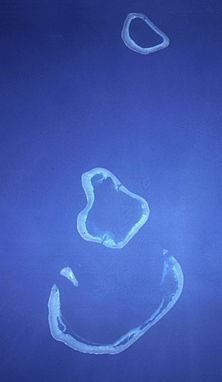Scott and Seringapatam Reefs facts for kids

Scott and Seringapatam Reefs from STS-80 at 359 km (223 mi) altitude on 29 November 1996.
|
|
| Geography | |
|---|---|
| Location | Indian Ocean |
| Coordinates | 14°3′S 121°46′E / 14.050°S 121.767°E |
| Administration | |
| State | Western Australia |
| Reef | Scott and Seringapatam |
| Demographics | |
| Population | 0 |
| Additional information | |
| Time zone | |
The Scott and Seringapatam Reefs are a group of atoll-like reefs. They are found in the Timor Sea, about 300 kilometers (186 miles) northwest of Cape Leveque, Western Australia. These reefs sit on the edge of the continental shelf, which is like the underwater edge of a continent.
This group includes three or four separate reef structures. It depends on whether Scott Reef Central is counted as its own reef. These reefs are just one of many reef formations located off the northwest coast of Australia. They are part of Western Australia. Other nearby reefs include Ashmore and Cartier Islands to the northeast and the Rowley Shoals to the southwest.
Contents
Exploring the Reefs: Location and Features
Each of these reefs rises very steeply from the seabed. The seabed here is about 400 to 500 meters (1,300 to 1,600 feet) deep. Much of the reef area becomes dry when the tide is low. Besides Sandy Islet, which is part of Scott Reef South, there are only a few rocks and sandbanks that stay above the water when the tide is high.
Scott Reef South: A Unique Crescent Shape
Scott Reef South is also known as Horseshoe Reef. It is a large reef shaped like a crescent moon. This reef has a rare and unusual double reef crest, which means it has two raised edges. Its lagoon, which is the calm water area inside the reef, is deeper than 24 meters (79 feet) in most parts. This reef and its lagoon cover an area of 144 square kilometers (56 square miles).
Scott Reef Central: Close to Scott Reef South
Scott Reef Central is sometimes considered part of Scott Reef South because it is very close. It lies off the western end of Scott Reef South. Here you will find Sandy Islet, located at 14°03′S 121°46′E / 14.050°S 121.767°E. This islet is about 690 meters (2,260 feet) long from north to south and up to 110 meters (360 feet) wide. It covers an area of 9 hectares (22 acres).
This reef dries out for about 0.8 to 1.6 kilometers (0.5 to 1.0 miles) from the islet at low tide. There is a tall tower on the islet. You can also see a large rock, about 2.4 meters (7.9 feet) high, near its northern end. A separate small reef, which dries out by 0.6 meters (2.0 feet), is located 2.4 kilometers (1.5 miles) northeast of Sandy Islet. The water passage between Scott Reef South and Scott Reef Central is only 33 meters (108 feet) deep. This is much shallower than the passages between the other reefs. For example, the passage between Scott Reef South and Scott Reef North is 366 meters (1,201 feet) deep.
Scott Reef North: A Large Circular Reef
Scott Reef North is a large reef that is almost circular in shape. It is located 23 kilometers (14 miles) southwest of Seringapatam Reef. This reef has a narrow crest, which is the highest part of the reef. Behind the crest are wide, flat areas of reef that become exposed at low tide. It also has a deep central lagoon. This lagoon connects to the open sea through two channels that look like river deltas. The reef and its lagoon together cover an area of 106 square kilometers (41 square miles).
Seringapatam Reef: Named After a Ship
Seringapatam Reef is located at 13°40′S 122°05′E / 13.667°S 122.083°E. It is 23 kilometers (14 miles) north of Scott Reef North. This reef is shaped like an egg and has a total area of about 50 square kilometers (19 square miles). This area is split almost evenly between its lagoon and the flat reef areas. Its narrow outer edge surrounds a fairly deep lagoon. Much of this reef also becomes exposed when the tide is low. There are large rocks around its edges. A few sandbanks, which rise about 1.8 meters (5.9 feet) above the water, can be found on the west side. Seringapatam Reef covers a total area of 55 square kilometers (21 square miles), including its central lagoon.
Captain Edwin Courtenay discovered this reef on August 23, 1839. He was on a whaling trip with his ship, the Seringapatam. He named the reef after his ship.
Browse Basin: Natural Gas Project
The Browse Basin Liquefied Natural Gas (LNG) project was a large plan to develop natural gas. It was being worked on by a company called Woodside Petroleum. This project included the Torosa gas field, which is located underneath Scott Reef South and Scott Reef North.
Coral Bleaching: A Threat to Reefs
In 2016, Scott Reef was greatly affected by coral bleaching. This happened during a worldwide coral bleaching event. About 80% of the corals on Scott Reef died during this time. Before this, there was another major coral bleaching event in 1998. During that event, "up to 80 percent of Scott Reef corals died." However, the reef was able to recover in the next 10 to 15 years.
In 2016, the heat stress on the corals was the highest ever recorded. Scientists measure this using something called NOAA Coral Reef Watch's Degree Heating Weeks. Because of ongoing climate change and the clear link between rising temperatures and coral bleaching, scientists are worried. They are concerned that coral bleaching events are happening more often. This means Scott Reef might not be able to recover and survive from the 2016 bleaching event.
See also
In Spanish: Arrecifes de Scott y Seringapatam para niños

